Grand Seiko
Grand Seiko: Poised for Greatness
A Grand Undertaking
In the Japanese market, the brand name “Seiko” is a source of national pride. It has been the country’s premier watchmaker for over a century. Grand Seiko had been the preserve of the special high-end watches produced in small numbers and generally only available in Japan, and the part of Seiko that deals with the domestic market was keen to keep the situation as it was. However, with international expansion, the need arose to single out Grand Seiko to function alone. It was left to company CEO Shinji Hattori, great-grandson of the founder, to make the all-important decision to separate it and Grand Seiko is now placed firmly at the top of the watchmaking structure controlled by Seiko Holdings Corporation. Hattori has even gone so far as to declare that he wants to see it as a top international luxury brand by 2020.
Divided into two parts, Grand Seiko has one arm dealing with mechanical movements (the 9S series) and one dealing with Spring Drive and quartz movements (the 9R and the 9F respectively), “9” indicating Seiko’s finest movements. Nominally, the mechanical movements are made by Seiko Instruments Inc. and the Spring Drive and quartz by Seiko-Epson.
The Grand Art of Precision
Grand Seiko watches today are defined by high precision, high legibility and aesthetics (or a Japanese sense of “beauty”), the same characteristics that helped define the brand throughout the 1960s. Ambition required that high precision was a necessary prerequisite for wins at the observatory competitions. High legibility was linked to high precision: a need to tell the time exactly. Aesthetics were formed from a wish to separate the Seiko watch from others in the market.
Grand Ambition
Grand Seiko’s aim going forward is to develop watches that are equal to, if not better than, its rivals at the same price point, but this will take time. Grand Seiko is not a watch firm to release models just for the sake of it. Although there are plans to grow – next year the estimate is approximately 10 per cent – it is a slow and steady philosophy: making sure that each step in development is secure before moving on.
Seiko’s ambition is grand, its dedication to manufacturing watches is grand, and the finish and timekeeping of the watches is equally – you guessed it – grand. It is not that Seiko was incapable of this in itself, but without the “Grand” part, there would be no separation or appreciation of that which pushes a Seiko watch into the luxury bracket. In order for Seiko’s premium range to be recognised across the globe, the separation of Grand Seiko is an absolute necessity.









